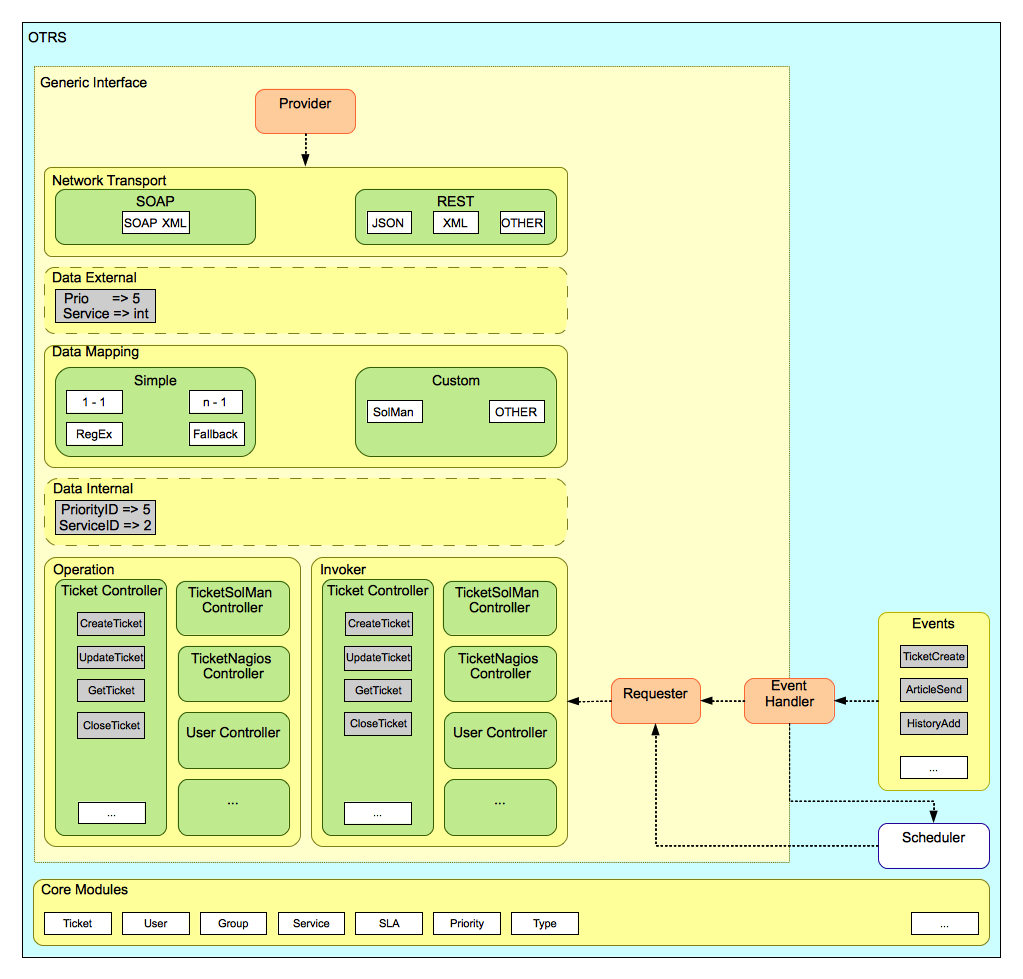Table of Contents
The OTRS Generic Interface consists of a multiple layer framework that lets OTRS communicate with other systems via a web service. This communication could be in two different directions:
OTRS as Provider: OTRS acts as a server listening to requests from the External System, processing the information, performing the requested action, and answering the request.
OTRS as Requester: OTRS acts as a client collecting information, sending the request to the Remote System, and waiting for the response.
Generic Interface is build based on a layer model, to be flexible and easy to customize.
A layer is a set of files, which control how the Generic Interface performs different parts of a web service. Using the right configuration one can build different web services for different External Systems without creating new modules.
Note
If the Remote System does not support the current bundled modules of the Generic Interface, special modules need to be developed for that specific web service.
The list of provided Generic Interface modules shipped with OTRS will be updated and increased over time.

Figure: The graphical interface layers.
This layer is responsible for the correct communication with the Remote System. It receives requests and generates responses when acting as provider, and generates requests and receives responses when acting as requester.
Provider communication is handled by a new web server handle called "nph-genericinterface.pl".
Requester communication could be initiated during an event triggered by a Generic Interface module or any other OTRS module. This event is catched by the event handler and depending on the configuration the event will be processed directly by the requester object or delegated to the Scheduler (a separated deamon designed to process tasks asynchronously).
This layer is responsible for translating data structures between OTRS and the Remote System (data internal and data external layers). Usually Remote Systems have different data structures than OTRS (including different values and names for those values), and here resides the importance of the layer to change the received information into something that OTRS can understand and on the opposite way send the information to each Remote System using their data dictionaries.
Example: "Priority" (OTRS) might be called "Prio" in a remote system and it could be that value "1 Low" (OTRS) should be mapped to "Information" on the remote system.
Controllers are collections of similar Operations or Invokers. For example, a Ticket controller might contain several standard ticket operations. Custom controllers can be implemented, for example a "TicketExternalCompany" controller which may contain similar functions as the standard Ticket controller, but with a different data interface, or function names (to adapt to the Remote System function names) or complete different code.
One application for Generic Interface could be to synchronize information with one Remote System that only can talk with another Remote System of the same kind. In this case new controllers needs to be developed and the Operations and Invokers has to emulate the Remote System behavior in such way that the interface that OTRS exposes is similar to the Remote System's interface.
An Operation is a single action that can be performed within OTRS. All operations have the same programming interface, they receive the data into one specific parameter, and return a data structure with a success status, potential error message and returning data.
Normally operations uses the already mapped data (internal) to call core modules and perform actions in OTRS like: Create a Ticket, Update a User, Invalidate a Queue, Send a Notification, etc. An operation has full access to the OTRS API to perform the action.
An Invoker is an action that OTRS performs against a Remote System. Invokers use the OTRS Core modules to process and collect the needed information to create the request. When the information is ready it has to be mapped to the Remote System format in order to be sent to the Remote System, that will process the information execute the action and send the response back, to either process the success or handle errors.